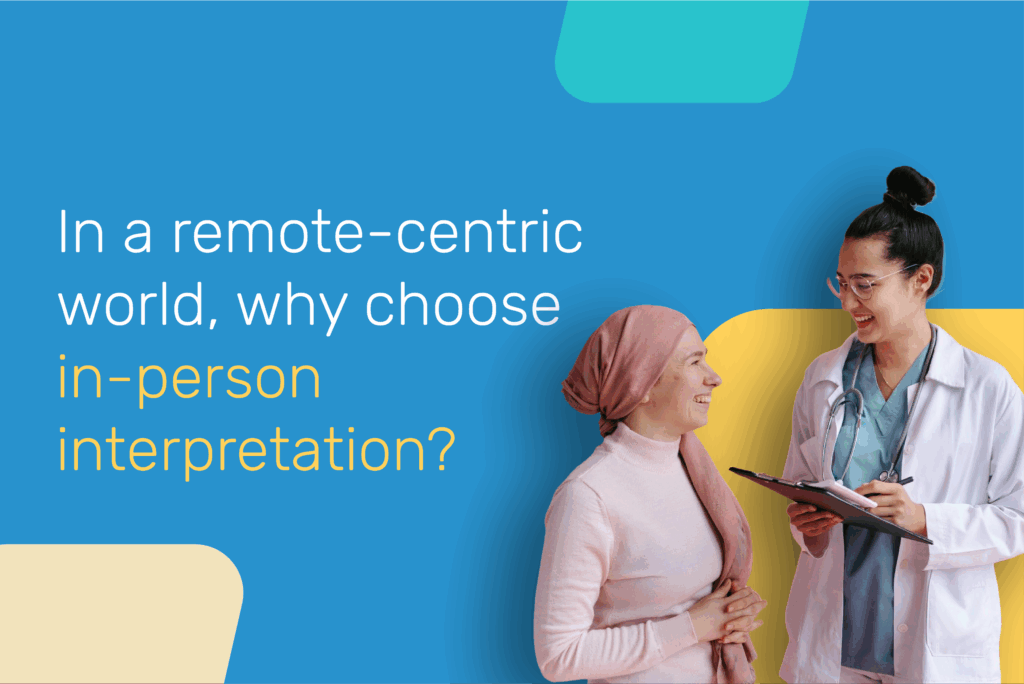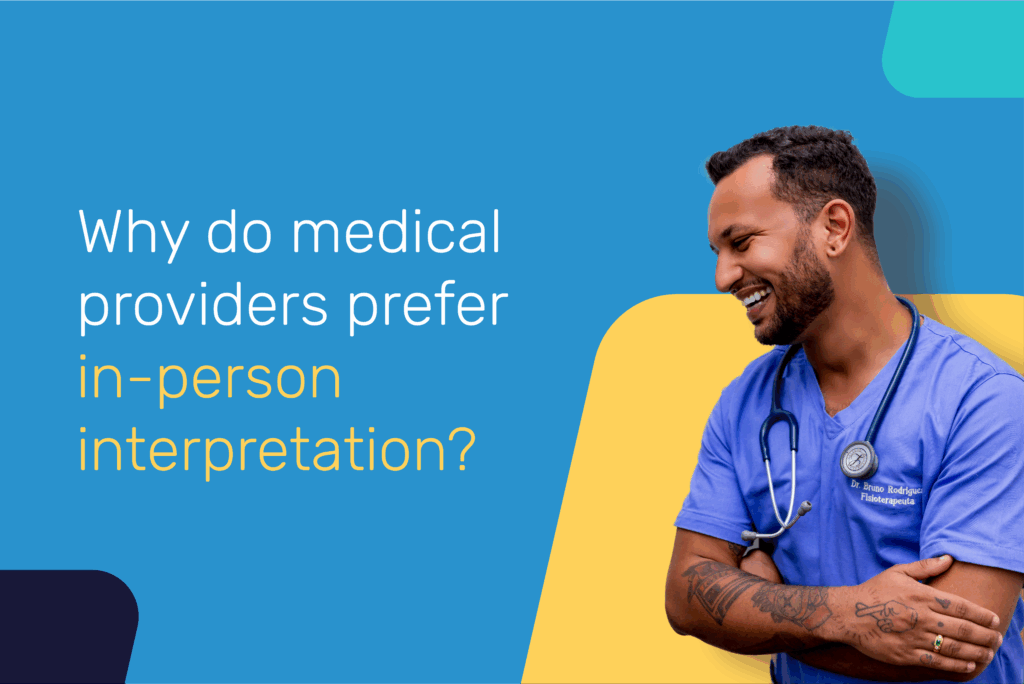In a remote-centric world, why do hospitals still opt for in-person interpretation?
This story begins in 2019. A study from the National Center for Health Statistics (NCHS) observed physician adoption of telehealth services soared to 86.5% in 2021, compared to 15.4% just two years prior.
As physicians increasingly adopted telehealth, particularly during lockdown periods, hospital language access administrators adapted their strategies. Demand for video remote interpretation (VRI) and over-the-phone interpretation (OPI) surged during this period, serving both telehealth and in-person visits.
What do these trends reveal about language access and technology? For starters, there is no doubt that increased investments in VRI and OPI infrastructure were a boon to patient-centered care. Suddenly patients with limited English proficiency (LEP) and Deaf patients had expanded opportunities to communicate with physicians. This outcome was a significant development, particularly given those communities are less likely to seek medical care due to communication barriers. On the physicians’ side, telehealth and remote interpretation enabled continuity amid facility access restrictions and were later integrated into regular practice after the lockdowns concluded.
Today, considering the rapid rise of remote-centric services, the data lags behind progress. Many questions remain unanswered. Healthcare organizations find themselves asking:
- Can virtual-based healthcare supplant select in-person services entirely, including language access?
- Is in-person care the only way forward?
- Or, is there a time and place for both? If so, what does a hybrid approach look like?
A recent study, albeit a small one, revealed several important data points that could influence the answers to these questions and shape the future of language access in hospitals. We unpack the study’s outcomes in the discussion below.
Do patients prefer in-person interpretation or virtual interpretation? How about physicians?
In a study published in May 2025, six researchers aimed to compare interpretation methods and determine whether remote or in-person options had an impact on patient care. They surveyed 303 Spanish-speaking patients and interviewed 19 clinicians from three Community Health Center organizations in California. Patients were asked to rate their experiences with in-person and remote interpretation, and physicians were asked to share their preferences regarding these methods.
The results were surprising. From the patients’ perspectives, the study found no preference for either method; in-person, video, and phone yielded comparable post-visit satisfaction rates. In contrast, clinicians expressed a strong preference for in-person interpreters.
What reasons did the clinicians cite? There were six themes in total:
- Effective communication and clinician-patient relationships
- Operational efficiency
- Cost effectiveness
- Enhanced quality control and reduced privacy risks
- Considerations when integrating external personnel
- Limited use of audio-video medical interpretation
This study did not delve into the specifics, but we can explore a few possible reasons why the physicians made their conclusions based on adjacent research.

Cultural competence: a bridge to strong clinician-patient relationships and effective communication
Cultural competence impacts communication and rapport-building. In a separate study at the University of California, San Francisco (UCSF), clinicians rated their own cultural competence as higher when an in-person interpreter supported an interaction as compared to a video interpreter. This outcome suggests that the on-site presence of an interpreter may facilitate a richer exchange of information, especially when cultural differences are present, impacting clinician decision-making and confidence.
Opportunities to drive operational efficiency and cost effectiveness
Efficiency and cost-effectiveness are among the key benefits of video remote interpreting. When staff have access to adequate training and equipment, connecting to a video interpreter of a commonly spoken language, such as Spanish, should take under a minute and often costs less than an on-site interpreter.
It is possible that the clinicians preferred to work with on-site interpreters who were coordinated in advance to support LEP patients, but we cannot be certain. In such scenarios, appointment stacking enables clinics to optimize efficiency and spending while delivering optimal, in-person services. Alternatively, when circumstances are urgent, such as interactions in the emergency department, partnering with an interpreter in the patient’s room may be perceived as more accessible and responsive to the situation.
Since medical assistants and nurses are typically involved in facilitating the logistics of both interpretation methods, more data is needed to better understand the clinicians’ reasoning.
Enhanced quality control and reduced privacy risks
Patients do not consider privacy risks as often as clinicians do, who are held accountable to HIPAA and other regulations. In the eyes of a risk manager, every external connection point represents a liability, which is why privacy and HIPAA compliance are incumbent on language access providers and platforms. When working with the same on-site interpreter regularly, clinicians can gain a sense of familiarity, which may alleviate concerns about quality or patient privacy.
Navigating language access decisions for your hospital or healthcare organization
Returning to the original question: why are hospitals continuing to offer on-site interpretation along with video and phone-based services?
While some quantitative patient satisfaction surveys may show comparable overall ratings across modalities, qualitative feedback from patients reveals a preference for the personal connection and ease of understanding afforded by in-person interpreters. More definitively, healthcare clinicians at the forefront of patient communication express a strong preference for in-person interpretation, citing its superiority in facilitating nuanced dialogue, building rapport, navigating cultural differences, and ensuring quality.
More studies are needed to gain a clearer picture of the role of technology in healthcare language access. That said, based on available data, our review suggests that in-person, on-site interpretation must remain a cornerstone of hospital language access to support effective communication and LEP patient care.
As a language services organization that provides all three types of interpretation services—in-person, video, and phone-based—Hanna is interested in understanding what is best for our clients, who, in turn, are focused on optimal patient care. Learn more about how we partner with hospitals and healthcare organizations to expand language access for LEP patients and Deaf patients.


